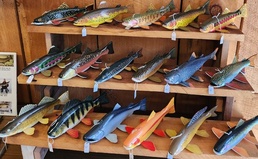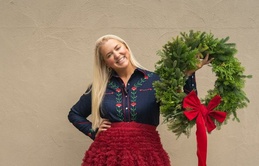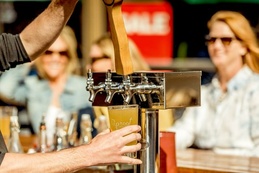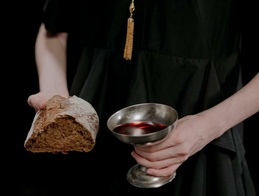An inside look at Ethiopian coffee farmers
Jan. 30, 2011
Brewing up hope: An inside look at the lives of Ethiopian coffee farmersBy Anne Stanton
This article is the second report of the Run Across Ethiopia (See Jan.
17 issue). Journalist Anne Stanton accompanied 10 American runners on
a two-week trip that began on January 5.
With a tears-of-joy finish last week, 10 American and six Ethiopian
runners ended a 250-mile jog across southern Ethiopia in a remote and
rural village where thousands gathered to celebrate.
The run—which raised $150,000 to build three village schools—was the
brainchild of Chris Treter, the owner of Higher Grounds Trading
Company in Traverse City. With a plodding running style described as
“Buddha like,” Treter is hardly the picture of a stick-thin
marathoner, but he shares the love of running with Ethiopia, which
boasts some of the world’s fastest runners. Treter said he organized
the run to help the children of impoverished coffee growers who live
in the lush, mountainous Sidamo region where he buys coffee beans.
Seven of the 10 Americans--all but four from the Grand Traverse
region--ran the entire distance despite diarrhea, nausea, and nearly
crippling muscle cramps. A handful of runners even added an extra 25
miles at the end of the run just for kicks. Three runners had to
temporarily sit on the bus due to a sprained ankle, as well as illness
and heat exhaustion. (Dan Zemper, an exercise physiologist and
therapist, went along for coaching and emergency muscle repair).
The website, Run Across Ethiopia (onthegroundglobal.org), has great
video footage, blogs and photos of the run, which was capped by two
joyous and musical celebrations in two different villages.
The story of the runners makes compelling reading, but I also wanted
to interview the coffee growers. So did Jacob Wheeler, who is writing
articles for the Glen Arbor Sun, the Rotarian and Traverse Magazine.
We had long heard that coffee growers are poor and reap very little of
the money that’s spent on the world’s annual $80 billion caffeine
addiction. But what does this poverty look like? On the eleventh day
of the run, we were driven with two interpreters to the tiny village
of Hase Gola, which lies just south of the town of Dilla.
The deeply rutted dirt road was long and lined with round huts and
lush vegetation. I had been at Hase Gola the day before when thousands
of villagers threw a party of gratitude for a four-room school that’s
getting built as a result of the run. The existing school buildings
are made of sticks and have hard mud floors and a single blackboard.
During the rainy season, the floors liquefy into mud. Scores of kids
sit shoulder to shoulder on six-inch wooden boards with no food; they
use the outdoors as their bathroom. An estimated 75% of girls drop out
when they hit puberty because the school lacks bathrooms, the school’s
principal told me.
Jacob and I were asked to drop off school supplies that the runners
had donated, but school was closed because it was the day of Epiphany,
the country’s biggest holiday. We decided to seek out the construction
supervisor to keep the school supplies safe.
A crowd of kids quickly appeared and watched as we counted out and
handed over the pencils, notebooks, and … pipe cleaners. There was
great curiosity over the latter. “What are these for?” I attempted a
demonstration, bending them into shapes, but couldn’t come up with any
practical use and suggested they were toys. The adults looked baffled.
After that, I took lots of pictures with my digital camera of the
kids, who exploded in laughter. I suspect that most were seeing
themselves for the first time since there are no mirrors at home. I
explained, through my interpreter Bekele, that Jacob and I would like
to talk to a coffee grower and see the inside of a hut. A serious
looking older boy by the name of Abraham quickly volunteered his home,
which was close by. Twenty kids turned into forty as Abraham led the
way. By then, as the only white person for hundreds of miles around,
I had grown used to being a spectacle. (Some of the toddlers burst
into tears and ran away from us in fear!)
Abraham introduced me to his dad, Joggile Roba Sonago, an older man
with an eye that was scarred shut. Flies swarmed on his missing eye,
but he didn’t appear to feel them.
I asked Joggile and his wife to describe their day. Joggile explained
that they wake up at 6:30 a.m. and pray. He goes off to do the farm
work and comes home at 9 a.m. for breakfast and coffee. She begins her
day with a trip to a nearby water well. She cooks up cereal for the
family, which is made up from grinding and cooking the root of the
false banana tree. They’ll eat only one more meal that day, Joggile
said.
The family stays inside the dark hut during the hottest part of the
day and leave to work again around mid-afternoon. The couple had 13
kids, but eight died in childhood. He said they had no money for
hospital care; his own eye, when infected, was removed by a foreign
doctor and sewn shut. Abraham, at 18, is now the youngest. Their two
daughters, both with toddlers in tow at the hut, are married. Joggile
told me he didn’t know how much money he made or how old he was.
Joggile owns a hectare of land, which equates to about two acres.
Besides coffee beans, he also grows enset or false banana plants, a
food staple in Ethiopia. He and his family showed me into the hut,
where a small fire was burning and invited me to sit on a little stool
near the door. I looked over to the hut’s center where a bed was
draped with a mosquito net. Abraham gave me a tour, pointing to a thin
white plastic mat where he slept and a small white bag with the
family’s few pieces of clothing. A big kettle was used to make afato,
a cereal of some kind.
A black umbrella, decrepit with age and black soot, sheltered the food
to keep it dry. The hut was semi-dark with light streaming through the
thin trees that comprised its smoke-colored dark walls and ceiling.
Chickens pecked around the fire and strips of meat hung drying over a
stick. There’s no electricity, of course, and no bathroom.
Joggile said he didn’t send his older children to school because he
didn’t think it was important. He now understands it’s the only way to
move forward. I asked Joggile if he was happy. Bekala interpreted:
“They are very happy. They get along and help each other.”
The day was growing hot and Bekala and the other interpreter,
Nagasene, were anxious to go. A handsome teen named Tombur took me to
his dad, W/Aregay Kebad, an older, but healthy looking man of 71.
(Elders are rare here; Ethopians die at the average age of 46).
Fourteen people live in his hut, he said, including two orphans they
took in. Besides coffee beans, he cultivates a garden of sweet
potatoes and false banana plants.
“He started working in the fields when he was 15 years old and quit
his education because of an unfortunate event, but said he sends all
his children to school. He always works hard and doesn’t choose
between jobs. He does all jobs that come his way. He never says no to
work,” interpreted Nagasene.
Tombur was going to school in Addis Ababa, but recently returned home
to work because his parents ran out of money.
W/Aregay said he joined the Oromia Coffee Farmers Cooperative Union,
which pays coffee farmers a fair trade premium. He gets twice as much
money now, but it still isn’t enough.
“Where is all the money going?” I asked, telling him the amount of
money my husband and I spend on coffee a year. He gasped.
“There is always someone between the coffee farmer and the coffee
drinker,” he said.
Does it make you angry to earn so little?
“Yes! That money should be for the coffee farmers. We work hard every day.”
James Weston, who is making a documentary of the Run Across Ethiopia
with his wife, Jamaica, had also done filming in the same village the
previous day. They followed an 11-year-old boy at his home and to
school with a video camera. (They’ll show the Ethiopian footage side
by side with Stella Young, an 11-year-old who goes to Glen Lake
School). Weston said the differences in their lives couldn’t be more
dramatic.
“He lives in a hut with six other people maybe the size of my small
motel room, and half of it’s fenced off for their goats and a cow,” he
said. “He slept in the same clothes that he wore that day. I think he
owned two pairs of pants, if that. He shared clothes with other
people—it was hard to tell. They only have one lamp for him to study
by. And that’s a miniscule flame. At night, they have a fire, which
covers the ceiling with oily black soot. They don’t have windows in
the house. The only light is through the doors, so they live in
constant darkness.”
But Weston added that the kids and the family seem at peace with their lives.
“They have so few material things, yet seem so content. They look
toward each other, and because of that, they seem so much happier and
joyful. Here in the developed world, we often look toward material
things to make us happy and satisfied.”
Jacob and I got back to the motel in Yirga Chefe, where I find Tadesse
Meskala, who is world famous for organizing 180,000 Ethiopian farmers
into 174 coffee cooperatives. The cooperatives belong to the Oromia
Coffee Farmers Cooperative Union. Meskala, the hero of the movie,
Black Gold, flies around the world to meet coffee roasters that are
willing to directly pay his cooperative farmers a higher price,
bypassing the commodities exchange. Cooperative Coffees, a group of 23
coffee roasters that includes Higher Grounds Trading Company, is one
of them.
The fair trade premium of 10 cents goes to improve the community: so
far the Oromia union has built 70 clean water projects, nine health
centers, 20 elementary schools, five high schools, and 60 additional
classrooms.
But why do the coffee farmers we met still live in such desperate poverty?
Meskala said that only 40% of the coffee growers in Hase Gola belong
to a cooperative. They are working to get all the farmers, but some
have suspicions about co-ops after a bad experience in the 1970s with
the Dirge regime. Another problem they are now fixing: the farmers
currently get an earlier payment in the form of a loan from private
buyers.
Do the individual farmers get more money by belonging to a cooperative
than the private buyer? Meskala says yes. Twice as much. Right now, a
co-op member is getting $1.70 per pound of coffee, equating to $2,200
a year for a farmer who is fully cultivating a hectare of land. This
is three times the amount of 1999 prices.
Yet that’s still a meager amount and money isn’t the only answer.
Meskala said that Green Mountain Coffee Roasters is funding projects
through Catholic Relief Services to ease poverty. First, it is helping
them diversify their crops to reduce the risk of crop failure.
Secondly, it is encouraging farmers to buy animals, such as cows or
goats that can provide milk. And third, it is engaged in microfinance. Also, with
the exploding population in the coffee region, the plot size of land
per family is shrinking, he said.
Another vital element: increasing the coffee bean productivity of a
single hectare. Meskala said that although a farmer could get 600
kilos of coffee beans from a hectare, they more often reap only 300.
They only have to plant more seedlings to double that amount, an
inexpensive and easy proposition.
Treter said that “fair trade” is now used as a marketing gimmick by
major corporations that promote their ethics with the fair trade
label, but, in reality, only purchase 1 to 2 percent of their coffee
under the fair trade certified scheme.
As I flew home from Ethiopia, I thought of the parallels between the
250-mile run and these impoverished coffee farmers. There were a few
days when runners would speed ahead (different ones on different
days), leaving the slower ones a good mile behind. Matt Desmond,
frustrated at trying to keep up during a bad bout of nausea, spoke up
during a runner’s meeting. “Everyone has to concern themselves with
the suffering runners. We need to pace ourselves with the runner who
is suffering the most that day. We started out as one team, let’s end
as one team.”
It seemed a metaphor for life.
Editor’s note: To finish the “Run Across Ethiopia” documentary, James
and Jamaica Weston need to raise a total of $5,000. If you’d like to
donate, go to kickstarter.com and search “Ethiopia.” For donations to
On the Ground, go to onthegroundglobal.net.
Outtakes from the
Run Across Ethiopia:
Poignant scenes observed during the 12-day run
By Anne Stanton
Favorite toy seen on the street: Kids rolling along a bike tire with a stick.
Favorite method of crowd control: Sticks.
Favorite method of goat control: Sticks.
Common sight on the street: Walking a bull on a leash.
After a searing, 30-mile run day under the equatorial sun, the
runners stayed in the Brothers Motel in the little town of Ziway
where the water didn’t flow out of faucets for hours at a time. One
desperate runner confessed at dinner that she cooled down her feet in
the toilet water. Bafflement ensued.
Dana Roskey, who heads up TESFA, a group that supports at-risk
Ethiopian runners warned the American runners, “There is almost no way
to avoid stomach upsets. You have to brush your teeth with bottled
water. “Whoops!” said 23-year-old runner Claire Evarhart.
The six Ethiopian runners who ran with the 10 Americans have a
difficult life, training twice a day and eating only one meal a day.
On the second day in Ethiopia, the running entourage visited the St.
Teresa Missionaries of Charity in the capital city of Addis Ababa. It
was Christmas day (in Ethiopia it falls on January 7) and Sister Marta
gave us a tour of the orphanage, as well as the men and women’s
medical wards for the crippled, deformed and destitute who don’t have
the means to stay in the hospital. Standing next to a Christmas tree
shaped from straw, she said, “There is bread enough for everybody, but
there is something unjust in the world. If everyone did just a little
bit …. It’s not the donations, but coming here and being with the
people that make a difference.” The missionary doesn’t turn anyone
away, she said.
After the last run, there was a gigantic celebration of villagers in
the small village of Afursa Waru where thousands gathered in
celebration. The village police, dressed in olive uniforms and
carrying guns or canes for crowd control, tried their best during the
long speeches to contain the crowd. But once the singing started,
folks pushed through the security line and started dancing in the open
space. The officers, taking the attitude of “if you can’t fight them,
join them,” temporarily gave up on crowd control and began dancing,
too. One cradled his Kalashnikov rifle in his arms as he got jiggy.
Seth Bernard and May Erlewine mixed it up with top Ethiopian jazz
musicians in Addis Ababa and also serenaded the villagers at the
beginning of the later runs. The bearded Bernard, who has a beatific
smile and long hair, was often mistaken for Jesus. One villager even
presented a picture of Jesus to him. “I get the Taliban as much as I
get Jesus,” said Bernard over a beer later that evening. “I prefer
Jesus.”
Most Beat-Up Feet Award after 250 miles would go to either Matt
Desmond, whose swollen feet resulted in painful blisters, or Hans
Voss, who ran 29 miles on a freshly sprained ankle. Unbelievably,
Desmond ran the entire route and Voss took only one day off.
Samrawit Moges, the first woman elected as a Rotary club president in
Ethiopia, told me in an interview of how a little boy sold a banana to
a woman, visiting from the U.K. They talked for a while through an
interpreter and he told her he’d prefer to go to school. The woman had
her own four children to support, but still sent extra money every
year to pay for school expenses. After he graduated from college, he
flew to England to personally thank her.
Water comes and goes in the motels (a bargain at $10 a night). But
videographers Jamaica and James Weston had a shower that wouldn’t turn
off. They just closed the door and imagined it was raining through the
night.
The effervescent Claire Everhart confessed to fellow runner Hans Voss
during a run about feeling guilty about having so much. “Anyone who
doesn’t feel guilty doesn’t have a heart,” he responded. “But what do
you do?” she asked. “Help build wells, build schools, but you can’t
hand out food,” he counseled. Later she told me of her favorite quote:
“Because you can’t solve all the problems of the world doesn’t absolve
you of the responsibility to fix the ones you can.”
Whenever something went wrong-such as getting locked into a bathroom
without a handle (as happened to me)—the response was a smile and the
acronym, “TIA.” This is Africa.
Mary Moore of Traverse City mastered the Ethiopian language, Amharic,
well enough to converse with the three Ethiopian female runners. They
loved the run and they really loved Mary, but Bekalesh said in an
interview that she was reminded of her own poverty-stricken childhood
as she ran through some of the poorest villages. Zinash said the run
was exciting, but found the glimpses of “wealth” during the trip, at
times, difficult.
James and Jamaica interviewed a handful of Ethiopian children about
what they would like to ask American kids. Here’s a recap:
After school, we are helping our family by taking care of animals and
picking coffee. What is the work of the people my age after school?
After school we bring water to our family and firewood for cooking and
making coffee. What do women of my age do?
When we harvest coffee, we can buy kerosene. But after four or five
months, our family is out of money. There is no light today because we
couldn’t buy kerosene. So, how do American children do it?
Blackboards are very difficult to write on. Do American kids use
blackboards like these?
Do you use computers?
Women have to marry by force. Is it the same for you? Women get
married and stay home and aren’t allowed to go to school. (Note: This
is now illegal in Ethiopia, but still goes on).
After we go to school, we stay here in the village. There are no jobs
after school. How is employment in America?
If your grades are low, you have no option to go to school. You have
to work on the farm. What do you do in America?
Trending

The Art of the Decoy
On mantles and shelves around the country (and indeed, around the world) sit intricate and beautiful wooden fish decoys that… Read More >>
Wreath the Halls
Get ready for the holidays with the ultimate wreath workshop! Boyne Mountain hosts Wreathfest, Saturday, Nov. 8, with Kalin … Read More >>
TC Beer Week Is Back!
Traverse City will be getting sudsy this weekend, as Traverse City Beer Week returns Nov. 7-15. This year, each day has a th… Read More >>


